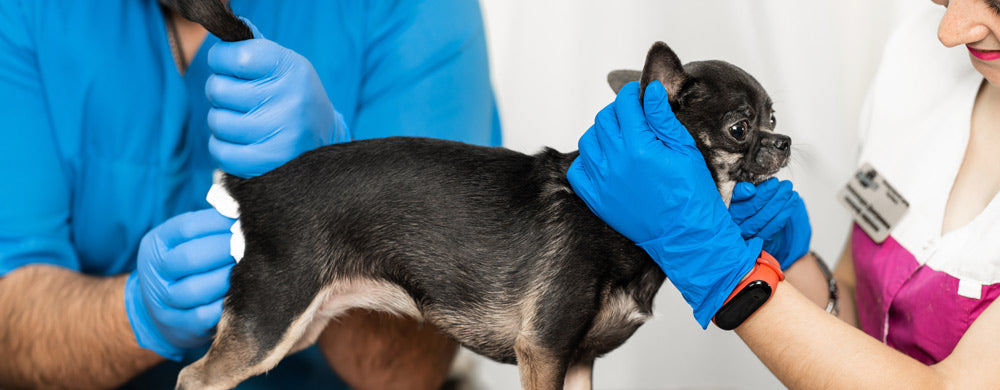Your basket is empty

Arthritis in Dogs: How to Recognise, Treat, Manage and Prevent
April 18, 2020 8 min read
Arthritis is a common condition that affects dogs of all ages and sizes, but it is most prevalent in seniors and large breeds. It causes stiff, swollen, and painful joints that make it increasingly difficult for your dog to move around.
To help you learn more about arthritis in dogs, we’ll be covering how to manage, treat, and prevent arthritis, as well as the condition’s different types and tell-tale signs.
---
WHAT IS ARTHRITIS?
Arthritis refers to the inflammation of the joints. Normally, the bone surfaces inside your dog’s joints are covered in a thin layer of cartilage that is lubricated with joint fluid. This lets the two surfaces easily glide over one another as your dog moves.
However, in dogs with arthritis, the cartilage inside the joints are damaged or worn out, which causes the bone surfaces to rub against one another rather than gliding. Not only does this cause discomfort for your dog, but it also damages the cartilage further.

The friction from the bone surfaces rubbing together causes new bone to form. The unneeded extra bone makes your dog’s joints stiffer, resulting in pain and decreased mobility.
Arthritis typically affects the joint areas in your dog’s elbows, hips, shoulders, knees, lower back, and wrists. There are a few different types of arthritis that can affect your dog, but the most common is osteoarthritis (degenerative joint disease).

In a 2019 study, it was shown that “osteoarthritis causes clinical signs in over 20% of dogs older than 1-year of age and 80% of geriatric dogs”. While arthritis can strike at any age, it’s most common in elderly dogs.
Additionally, certain breeds are more susceptible to developing the condition. Large and giant breeds like the German Shepherd, Golden Retriever, Labrador Retriever, and Rottweiler are typically more prone to arthritis, but small breeds can also get it. An example is the Dachshund due to the breed’s short legs.
Unfortunately, arthritis is not curable, which means your dog will have it for the entirety of their life. The condition can become so severe that it affects the quality of your dog’s life. They can suffer a great deal of pain, find it increasingly difficult to move about, and lose the ability to perform tasks like going to the bathroom. In these extreme cases, euthanasia is typically the kinder option.
Although, with the correct treatment, canine arthritis can be managed to improve mobility, joint function, and reduce pain. Common treatment methods include cartilage protectors, anti-inflammatory medication, and joint supplements. The right type of exercise and a good diet can also help arthritic dogs.
***
TYPES OF ARTHRITIS
There are a few different types of arthritis that dogs can suffer from. Identifying which one your dog might have can help you determine the best course of action.
OSTEOARTHRITIS
Also known as degenerative joint disease (DJD), osteoarthritis is the most common type of arthritis in dogs. It develops gradually and causes the loss of cartilage in your dog’s bones. This causes chronic joint inflammation, swelling, and pain.
RHEUMATOID ARTHRITIS
Rheumatoid arthritis (RA) is an autoimmune disease and causes your dog’s immune system to attack their joints and other body parts. This results in inflammation and damage to your dog’s joints.
RA is one of the less common types of arthritis in dogs, but it can affect small and toy breeds between the ages of 2 and 6. It’s also thought that the Nova Duck Tolling Retriever is predisposed to developing the disease.
IMMUNE-MEDIATED POLYARTHRITIS
In dogs with immune-mediated polyarthritis (IMPA), the immune system mounts an inflammatory response to the joints, which causes swelling, pain, and poor mobility.
The immune system mistakenly sends white blood cells to the joints. These white blood cells release enzymes and chemicals into the fluid that cover your dog’s joints, which disrupts the protective purpose of the fluid.
SYSTEMIC LUPUS ERYTHEMATOSUS
Systemic lupus erythematosus (SLE) is an immune-mediated disease and occurs when your dog’s immune system attacks their own tissue. Each tissue in your dog’s body consists of substances called antigens that can stimulate an immune system reaction. When your dog’s immune system reacts to antigens, it makes antibodies that induce an immune system response.
SLE can develop suddenly (acute) or gradually over time (chronic), and the severity of your dog’s symptoms depends on the area the immune system is attacking, such as the joints or skin.
SEPTIC ARTHRITIS
Septic or infective arthritis is caused by an infection that enters your dog’s joints through their bloodstream. Aerobic (bacteria that needs oxygen for growth), anaerobic bacteria (bacteria that doesn’t need bacteria for growth), and fungal organisms can all cause septic arthritis.
Bacterial infection from a wound, cut, abrasion, or opening after surgery can also cause septic arthritis.
***
WHAT ARE THE SIGNS OF ARTHRITIS?
As dogs cannot tell us when they’re experiencing pain or discomfort, it’s important to look out for signs that may indicate something is wrong. There are several signs and symptoms to keep an eye out for if you suspect your dog has arthritis.
- Limping/lameness
- Lethargy
- Stiff gait, typically worse just after exercise or waking up
- Cautious of affected joints being touched
- Difficulty moving about, such as climbing stairs or jumping on the sofa
- Reluctant to exercise
- Less active on walks
- Groaning or yelping
- Licking or biting at areas that might be swollen or painful
- Sleeping more than usual
- Grumpiness, quietness, or irritability
- Narrowing of the hips and back
- Swollen joints

***
HOW TO DIAGNOSE ARTHRITIS IN DOGS?
Arthritis typically comes on slowly or gradually, so the signs can often be mistaken for “slowing down” or “getting old”. However, it’s your responsibility as an owner to recognise when your dog is acting abnormally.
If you notice a change in your dog’s gait, posture, energy levels, or capability of performing certain activities like climbing the stairs and jumping onto the sofa, then arthritis could be the reason behind your dog’s unusual behaviour.
If you think your dog might have arthritis, then you should take them to your vet to get checked out. Some other conditions can have similar signs as arthritis, so it’s important to see a vet to get the right diagnosis.
At the examination, your vet will most likely take blood tests, urine samples, joint fluid, or X-rays to determine whether your dog has arthritis and which type they might have.
***
MEDICATION FOR ARTHRITIS IN DOGS
As mentioned earlier, there is no cure for arthritis, but there are treatments available to manage the condition and reduce pain or discomfort. There are three main types of drugs that are commonly used for dogs with arthritis: cartilage protectors, NSAIDs (anti-inflammatory drugs), and nutraceuticals (supplements).
Cartilage protectors help reduce cartilage damage, encourage the repair of joint structures, and reduce inflammation. NSAIDs are very effective at reducing inflammation caused by arthritis, but they can have severe side-effects and are not recommended for long-term use. The most common side-effects associated with NSAIDs are vomiting, diarrhoea, lethargy, anorexia, and black tarry stools.
Joint supplementation can have a number of benefits and are an ideal natural choice to use instead of or alongside cartilage protectors or NSAIDs. Supplements that contain omega-3 fatty acids, chondroitin, glucosamine, MSM, and green-lipped mussel are advantageous as they help reduce swelling, inflammation, and stimulate cartilage growth to increase mobility and lessen pain.
 Our MOBI Hip & Joint Glucosamine Supplement contains all of these ingredients, as well as Vitamin C, curcumin, and hyaluronic acid to support dogs with arthritis and joint issues. In addition to being 100% natural, MOBI is manufactured in the UK to GMP code to ensure product quality and safety.
Our MOBI Hip & Joint Glucosamine Supplement contains all of these ingredients, as well as Vitamin C, curcumin, and hyaluronic acid to support dogs with arthritis and joint issues. In addition to being 100% natural, MOBI is manufactured in the UK to GMP code to ensure product quality and safety.Feeding your dog supplements is often tricky and no small feat. Getting them to sit still and open their mouth can be an almost impossible task. Additionally, sprinkling or crushing supplements over your dog’s food isn’t easy either. Most dogs can quickly detect something different about their meal and refuse to eat it.
With this in mind, MOBI comes in a delicious chicken flavour to make feeding it stress-free. It’s also available in tablets or powder form.
It’s a good idea to speak to your vet to figure out the best type of medication for your dog. Additionally, contact your vet for advice before using supplements or home remedies for your dog, and never use human medication.
***
OTHER WAYS TO MANAGE ARTHRITIS IN DOGS
In addition to using supplements or medication, there are other ways to manage and help treat arthritis in dogs. A healthy weight, good diet, proper exercise, massages, among others are all helpful for reducing symptoms associated with arthritis.
Adapting your house to help your dog move around more easily is recommended. Changing your home to be more suited to your arthritic dog might include using an orthopaedic dog bed to support your dog’s joints, blocking off stairs, covering hard surfaces like laminated flooring with rugs, and using ramps to help your dog get down steps inside or outside your home.
Modifying your arthritic dog’s exercise routine is also important to ensure their symptoms don’t worsen. When there are new dogs, new smells, new people, or other exciting things going on, your dog can temporarily forget their pain to go play and investigate.
As your dog is running around and exploring, it might look like your dog is getting better and their symptoms have improved, but this isn’t the case. Don’t let your dog overdo it when they are exercising.
This might mean putting your dog on a lead, not letting your dog chase balls, avoiding steep or rough terrain, and cutting the walk short so your dog has enough energy to get home. Additionally, cold weather can also worsen arthritis symptoms, so using paw protectors, coats, or jackets might be a good idea to keep your dog warm.
Other alternatives like acupuncture, acupressure, laser treatment, hydrotherapy, surgery, dog chiropractors, and surgery are also worth considering.
***
HOW TO PREVENT ARTHRITIS IN DOGS?
It can be difficult to prevent arthritis in dogs as a lot of it boils down to genetics and age. However, there are a few things that can help reduce the chances of the condition occurring.
REGULAR VET CHECKUPS
Taking your dog regularly to the vet for health check-ups is a good prevention method for ensuring any issues are quickly detected and treated before they deteriorate.
WEIGHT MANAGEMENT AND DIET
Overweight dogs can struggle more with symptoms caused by arthritis than those of a healthy weight. Not only does carrying extra weight put more strain on your dog’s joints, but it also affects the inflammation within the joints due to the compounds found in fat.
If your dog is a bit on the heavier side, then it’s important to try and get them to a healthier weight. Take a look at what you feed your dog, how often you feed them, and when you feed them to see where you might be going wrong.
PROPER EXERCISE
Exercising your dog regularly is important for making sure their joints don’t seize up, but the right kind and amount of exercise is just as important. For example, breeds like English Bulldogs or Dachshunds shouldn’t be expected to go on long 3-hour treks or run alongside a jogger.
Additionally, walking or running on hard surfaces frequently can inhibit bone growth in puppies or put a strain on your dog’s joints and hips, particularly if they were loose to begin with. If you can, try to get your dog used to water and swimming when they are young.
Swimming is extremely beneficial for dogs as it strengthens muscles, keeps tendons and ligaments flexible, and helps with stiff joints. Exposing your dog to water while they are young will make it a lot easier to exercise them when they are older.
JOINT SUPPLEMENTS
Although joint supplements cannot prevent arthritis, they are incredibly advantageous for supporting your dog’s joints. Those that contain glucosamine and chondroitin, like our MOBI supplement, can reduce the loss of cartilage to aid with discomfort.
MOBI also contains green-lipped mussel which is rich in omega-3 fatty acids and curcumin to help steer off inflammation, as well as MSM, hyaluronic acid, and Vitamin C for additional support.
Also in Pet Advice

Should You Add Water to Your Dog’s Kibble? Here’s What the Science Says
August 14, 2025 7 min read
Should you add water to your dog’s kibble? Discover the science-backed pros, cons, and better alternatives like bone broth and fresh food to improve hydration, digestion, and overall canine health...

DIY Frozen Dog Treats Your Pup Will Love
June 27, 2025 4 min read
Summer heat can be dangerous for dogs, making hydration more important than ever. Learn how to spot signs of dehydration, boost your pup’s water intake, and create fun, frozen recipes to keep them happy and healthy all season long.

Why Is My Dog Scooting? Common Causes and How Diet Can Help
May 09, 2025 4 min read
If your dog is scooting or smells fishy, it could be due to blocked or irritated anal glands. Learn what causes blocked anal glands, which dogs are most at risk, and how simple dietary changes—like adding fibre and anti-inflammatory nutrients—can help prevent recurring problems.
